|
|
Also see Nest ID Matrix (contents) and Egg ID Matrix (color, spots, etc.)
To see other cavity nester bios/photos:
Also see chart to help ID nests by construction material.
 Black-capped Chickadee nest in ANBS box. Notice evergreen buds, moss, bits of bark in base. This nest filled up about 1/4 to 1/3 of the box.Photo by Bet Zimmerman. Black-capped Chickadee nest in ANBS box. Notice evergreen buds, moss, bits of bark in base. This nest filled up about 1/4 to 1/3 of the box.Photo by Bet Zimmerman.
Nest Description: Downy nest with moss base, topped with fur and soft plant fibers. Female may cover eggs with moss/fur when leaving the box. Very thin-shelled white/cream eggs with light brown/reddish speckles, dots or blotches, little or no gloss, spots may be concentrated more on the wide end of the egg. More about chickadees biology, nesting behavior and timetable. |
||
 Black-capped Chickadee nest in a small NABS box. See photo album of birds visiting the exterior of this box (shots taken with a birdcam).The egg below did not hatch. Photo by Bet Zimmerman. Black-capped Chickadee nest in a small NABS box. See photo album of birds visiting the exterior of this box (shots taken with a birdcam).The egg below did not hatch. Photo by Bet Zimmerman. |
||
 |
||
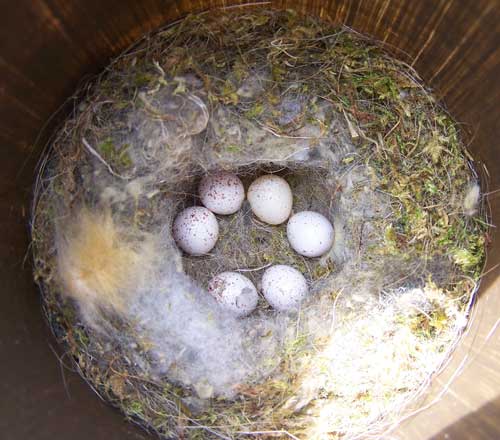 Black-capped Chickadee nest in a Gilberston box. Photo by Bet Zimmerman.Chickadees are capable of excavating their own cavity. They may prefer birches for excavation because the outer bark stays intact, while the inner bark gets soft when rotten. This may explain why they seem to be attracted to Gilberston PVC boxes painted to look like white birches. Black-capped Chickadee nest in a Gilberston box. Photo by Bet Zimmerman.Chickadees are capable of excavating their own cavity. They may prefer birches for excavation because the outer bark stays intact, while the inner bark gets soft when rotten. This may explain why they seem to be attracted to Gilberston PVC boxes painted to look like white birches.
Chickadee nests can be confused with Tufted Titmouse nests, especially in the early stages of construction. |
||
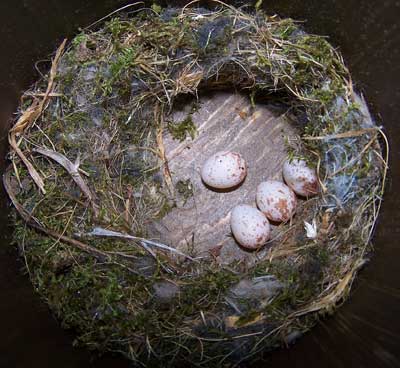 A Black-capped Chickadee nest in a Gilbertson box, with no nesting material underneath. Photo by Bet Zimmerman. A Black-capped Chickadee nest in a Gilbertson box, with no nesting material underneath. Photo by Bet Zimmerman.
The box is in a wooded area with no wren guard. The nest and eggs were removed two days later by a House Wren. |
||
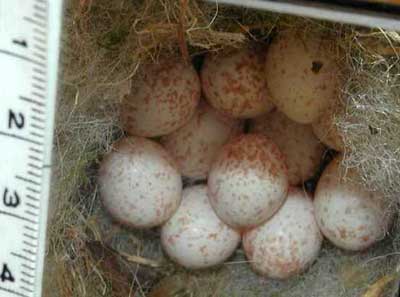 Photo by Pam Spielmann of NJ. ELEVEN eggs in one nest! Although chickadees may dump eggs in the nests of others, this was not egg dumping, as one egg was added every day. (It’s possible that another female showed up after the first was done laying, but that would be unlikely.) 6-8 eggs are typical, 13 were recorded once. Photo by Pam Spielmann of NJ. ELEVEN eggs in one nest! Although chickadees may dump eggs in the nests of others, this was not egg dumping, as one egg was added every day. (It’s possible that another female showed up after the first was done laying, but that would be unlikely.) 6-8 eggs are typical, 13 were recorded once. |
||
 Photo by Ed Wagaman of West Virginia. Photo by Ed Wagaman of West Virginia. |
||
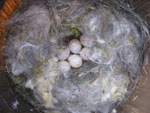 |
||
| Notice how much more “fluff” is in the nest above. Photo by Bet Zimmerman of CT | ||
 Black-capped Chickadee nest. Photo by Peter Kwa. There are two eggs (part of one is visible) to the right of the nestling in the nestcup, which did not hatch. Black-capped Chickadee nest. Photo by Peter Kwa. There are two eggs (part of one is visible) to the right of the nestling in the nestcup, which did not hatch.
The floor size on this nestbox is 4″ x 4″ so that the nestcup can be estimated to be about 2″ diameter. The moss base is about 1″ to 1.5″ thick. 1/2″ of pine shavings were placed under the moss base to entice Chickadees to nest. Most of the shavings were ‘excavated’ by the Chickadees. The fur lining is dog fur put in a suet cage about 20 feet away from the nestbox. At 8 days, the nestling was observed reaching for its preening gland and going through the motions of preening, even though it barely had feathers. |
||
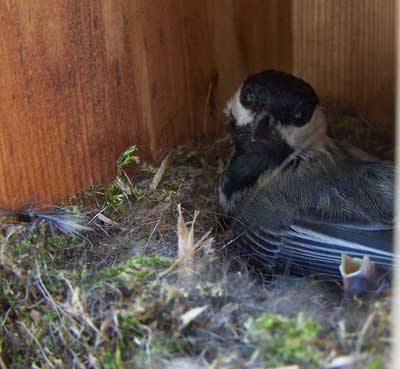 The mother sits tight when the box is opened. Notice baby in lower left gaping. Nestlings were born today. Photo by Bet Zimmerman. The mother sits tight when the box is opened. Notice baby in lower left gaping. Nestlings were born today. Photo by Bet Zimmerman. |
||
 |
||
 Hatching day. Notice how deep cup is. Photo by Bet Zimmerman. Hatching day. Notice how deep cup is. Photo by Bet Zimmerman. |
||
 Three day old chickadee babies. Photo by DH of Pam Speilmann of the Bluebirding Forum. (Photo taken using a mirror?) Three day old chickadee babies. Photo by DH of Pam Speilmann of the Bluebirding Forum. (Photo taken using a mirror?) |
||
 6 day old BCCHs. Photo by Bet Zimmerman. 6 day old BCCHs. Photo by Bet Zimmerman. |
||
 Black-capped Chickadees in a Gilberston box. Not sure what day they hatched. One unhatched eggs egg. It was infertile (I find that infertile eggs float.) Photo by Bet Zimmerman. Black-capped Chickadees in a Gilberston box. Not sure what day they hatched. One unhatched eggs egg. It was infertile (I find that infertile eggs float.) Photo by Bet Zimmerman. |
||
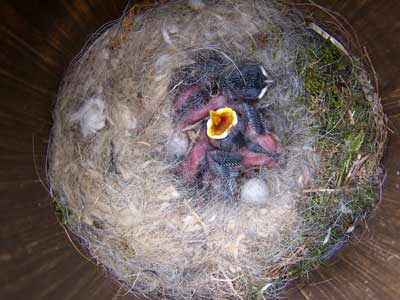 Another BCCH nest in a Gilbertson box. Photo by Bet Zimmerman. Notice two unhatched eggs eggs. Another BCCH nest in a Gilbertson box. Photo by Bet Zimmerman. Notice two unhatched eggs eggs.
Chickadees have also been known to nest in rotted wooden fence posts and open stumps. See photos. |
||
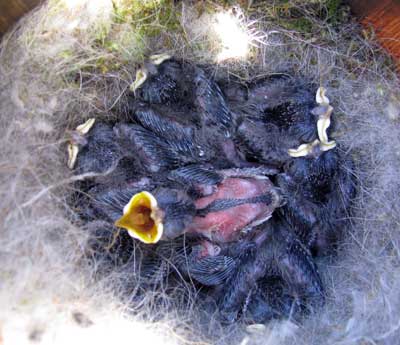 BCCH nestlings. About a week old. Photo by Bet Zimmerman. BCCH nestlings. About a week old. Photo by Bet Zimmerman. |
||
 11 day old BCCH nestlings. Photo by Bet Zimmerman. 11 day old BCCH nestlings. Photo by Bet Zimmerman. |
||
 12 day old BCCH nestlings. Photo by Linda Moore. Only 2 of the 5 eggs that were laid hatched. 12 day old BCCH nestlings. Photo by Linda Moore. Only 2 of the 5 eggs that were laid hatched.
The fur from Linda’s golden retriever was used. She was surprised at how quickly the nest was constructed. They can make a nest in 3-4 days. See All About Chickadees. |
||
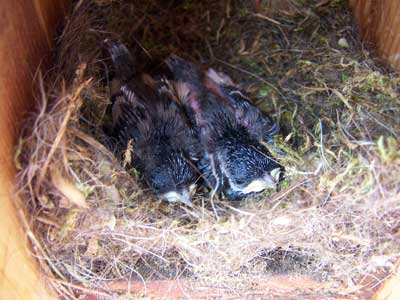 6/9/07. There were 5 BCCH nestlings until I removed the Wren Guard – then 3 disappeared. These two were left, and are on Day 13 (with Day 1 as hatch day). Photo by Bet Zimmerman. 6/9/07. There were 5 BCCH nestlings until I removed the Wren Guard – then 3 disappeared. These two were left, and are on Day 13 (with Day 1 as hatch day). Photo by Bet Zimmerman. |
||
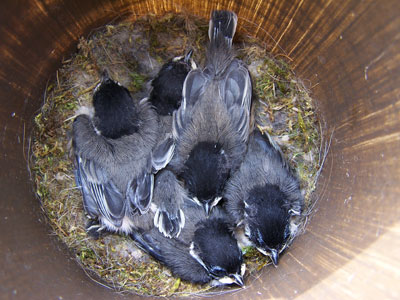 These BCCH chicks hatched more than 10 days ago. Photo by Bet Zimmerman. The nest was protected by a Wren Guard. These BCCH chicks hatched more than 10 days ago. Photo by Bet Zimmerman. The nest was protected by a Wren Guard. |
||
 |
||
 One of Linda Moore’s fledglings. One of Linda Moore’s fledglings. |
||
 A chickadee nest after fledging. Somewhat flattened, no fecal sacs. See full resolution version. Photo by Zimmerman A chickadee nest after fledging. Somewhat flattened, no fecal sacs. See full resolution version. Photo by Zimmerman |
The student of Nature wonders the more and is astonished the less, the more conversant he becomes with her operations; but of all the perennial miracles she offers to his inspection, perhaps the most worthy of admiration is the development of a plant or of an animal from its embryo.
-Thomas Henry Huxley, British biologist and educator. Reflection #54, Aphorisms and Reflections, selected by Henrietta A. Huxley, Macmillan, 1907.
